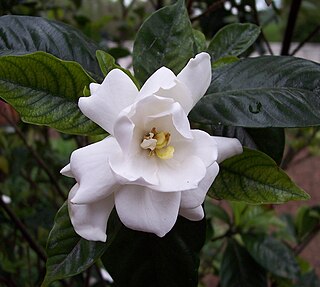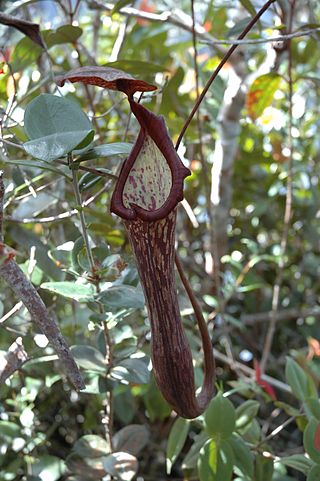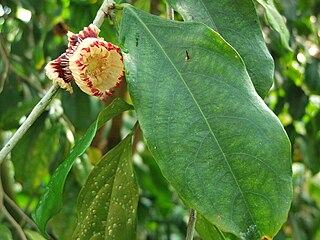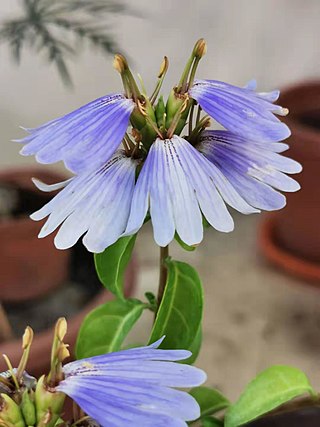
Gardenia is a genus of flowering plants in the coffee family, Rubiaceae, native to the tropical and subtropical regions of Africa, Asia, Madagascar, Pacific Islands, and Australia.

Anthocleista is a genus of tree- and shrub-like tropical plants in the subtribe Potaliinae in the Gentian family. There are between 14 and 16 species in the genus, native mainly to tropical Africa, including Madagascar and the Mascarene Islands. Anthocleista was once placed in the family Loganiaceae, but more recent molecular, morphological, and phytochemical evidence has placed the group well within the Gentianaceae.

The Lecythidaceae comprise a family of about 20 genera and 250–300 species of woody plants native to tropical South America, Africa, Asia and Australia.

Nepenthes fusca, or the dusky pitcher-plant, is a tropical pitcher plant endemic to Borneo. It is found throughout a wide altitudinal range and is almost always epiphytic in nature, primarily growing in mossy forest.

Nepenthes faizaliana is a tropical pitcher plant endemic to the limestone cliffs of Gunung Mulu National Park in Sarawak, Borneo. It is thought to be most closely related to N. boschiana.

Nepenthes vogelii is a tropical pitcher plant endemic to Borneo. It is thought to be most closely related to N. fusca.

Nepenthes platychila is a tropical pitcher plant endemic to the Hose Mountains of central Sarawak. It is notable for its smooth peristome and funnel-shaped upper pitchers. Nepenthes platychila belongs to the loosely defined "N. maxima complex", which also includes, among other species, N. boschiana, N. chaniana, N. epiphytica, N. eymae, N. faizaliana, N. fusca, N. klossii, N. maxima, N. stenophylla, and N. vogelii.

Tephrosia is a genus of flowering plants in the family Fabaceae. It is widespread in both the Eastern and Western Hemisphere, where it is found in tropical and warm-temperate regions.
Napoleonaea egertonii is a species of woody plant in the family Lecythidaceae. It is found in Cameroon, Gabon, and Nigeria. Its natural habitat is subtropical or tropical moist lowland forests. It is threatened by habitat loss.

Napoleonaea is a genus of woody plant in the family Lecythidaceae first described as a genus in 1804, the same year its namesake crowned himself Emperor of the French. The genus is native to Africa.
Napoleonaea lutea is a species of woody plant in the family Lecythidaceae. It is found only in Nigeria. It is threatened by habitat loss.

Sclerochiton is a genus of flowering plants in the family Acanthaceae. It includes 18 species native to tropical and southern Africa.

Tephrosin is rotenoid. It is a natural fish poison found in the leaves and seeds of Tephrosia purpurea and T. vogelii.

Pitcher-Plants of Borneo is a monograph by Anthea Phillipps and Anthony Lamb on the tropical pitcher plants of Borneo. It was first published in 1996 by Natural History Publications (Borneo), in association with the Royal Botanic Gardens, Kew and the Malaysian Nature Society. An updated and much expanded second edition was published in 2008 as Pitcher Plants of Borneo, with Ch'ien Lee as co-author.

Tephrosia vogelii, the Vogel's tephrosia, fish-poison-bean or Vogel tephrosia (English), tefrósia (Portuguese) or barbasco guineano (Spanish), is a flowering plant species in the genus Tephrosia.
Nepenthes epiphytica is a tropical pitcher plant known only from the Berau and East Kutai Regencies of East Kalimantan, Borneo, where it grows at an elevation of around 1000 m above sea level. Prior to its formal description as a species, N. epiphytica was considered to be a variant of the closely related N. fusca. Nepenthes epiphytica belongs to the loosely defined "N. maxima complex", which also includes, among other species, N. boschiana, N. chaniana, N. eymae, N. faizaliana, N. fusca, N. klossii, N. maxima, N. platychila, N. stenophylla, and N. vogelii.

Euriphene amicia, the friendly nymph, is a butterfly in the family Nymphalidae. It is found in Sierra Leone, Liberia, Ivory Coast, Ghana, Togo, Nigeria, Cameroon, the Republic of the Congo and the Democratic Republic of the Congo. The habitat consists of forests.

Napoleonaea imperialis is a small, evergreen tropical West African tree in the family Lecythidaceae, native to Africa.
Scleria vogelii is a stout perennial plant in the sedge family Cyperaceae. It grows naturally from western to central Africa in savanna and swampy forests.

Peponium is a genus of flowering plants belonging to the family Cucurbitaceae.

















